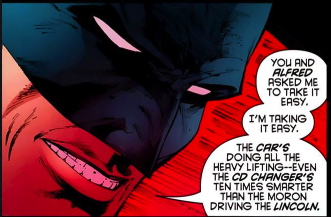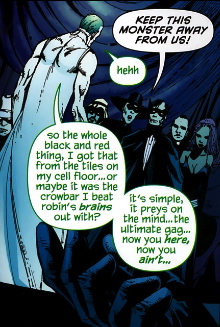
Note: I am reprinting, without change, a series on Grant Morrison’s Batman work originally printed in 2013 on my old site.
I can’t tell you how many conversations I’ve had about the title “Batman R.I.P.” What does it even mean? Batman doesn’t die during it. In fact, ironically, he already died—for four minutes in Batman #672, which I discussed in my last post in this series.
And then there was the panel, above, from Legends of the Dark Knight #199…
So what does it mean? I think it means, literally, “Rest in Peace.” Batman can’t rest (of course). And the story even opens with that theme: The splash page says “Batman and Robin will never die!” and then launches into a standard chase scene (after a brief visit with Dr. Hurt, just to remind us he’s around and up to no good) during which Batman recognizes that both Alfred and Robin think he needs a rest….
Of course, a resting Batman is boring…
One of the most interesting things about Batman RIP is Bruce Wayne’s blindness to the fact that Jezebel Jet is a double agent. In the second issue of the arc he even sees it, he tells her that his enemies would use his love for her as a weapon against Batman—but his denial and need to be loved is so thick that he can’t see that that is, in fact, what is actually happening.
I should note that before Batman RIP, Bats goes to visit Joker in Arkham. This short tale is told as part of DC Universe Presents #0. It’s a red-and-black checkerboard visual, and a discussion between the two frenemies. It’s never been entirely clear what all the red-and-black means, but it appears throughout Morrison’s epic and pretty much comes to an end here in RIP. We’ll talk about it more later in this post.
The first two issues of the official RIP story introduce the full Black Glove cast of characters and show Batman recognizing the connection between an old film starring the slain John Mayhew and this new nemesis. We also see Batman beginning to crack. And, finally, the boundary between Bruce and Batman appears to be gone. Jezebel Jet knows his identity. Black Glove knows it. Commissioner Gordon comes to Wayne Manor, presumably to look for Batman. It is here that Morrison is breaking down the concepts of identity and secrecy, and removing them to explore how Batman would function if he were not a duality. In earlier issues, Dick Grayson and Alfred, and Jezebel, keep telling Bruce and/or Batman to relax and be at peace. But without his torment, without his duality, what really would happen? This seems to be what Joker tells him in DC Presents #0. Of course, he speaks in typical cryptic fashion, so his real message is never 100% clear.
And speaking of Grayson, a few issues back one of Batman’s Black Casebook files went missing—the diaries of his weirdest cases. In #678, we learn that Grayson stole it. It’s a chapter from year 5 of Batman crusade, and it talks about Joker—and how Batman wants to be able to think like a psychopath. This triggers something in Grayson—but it’s never clear what. In any event, Dick springs into action to go help Batman fight Black Glove.
While Dick is getting caught up, an unconscious and amnesiac Bruce Wayne is found in an alley by a junkie named Honor Jackson. We’ve seen him before, in the very first Morrison issue, pushing a shopping cart around the Zur En Arrh-ridden streets of Gotham. Honor shoots Bruce with heroin, and that “street substance” seems to revive (at least partly) Bruce’s memory, which makes sense. Bruce wants to “think like the enemy.” He’s been dosed, over and over, with Black Glove’s hallucinogens and pathogens. He claims to know the antidote for every toxin known to man. But it is the drugs of the streets of Gotham that save him. Batman’s relationship with his city has been a constant, but Morrison was the first person to really make the city a supporting character.
Bat-Mite is back, too. It’s not clear if he’s friend or foe to Batman (i.e., if he’s the devil or an angel on Batman’s shoulder), but the heroin overdose wakes Bruce up enough to know to listen to the city instead of Mite…

The parallels between Batman and his own son, Damian, begin to become clearer. Dr. Hurt is dressed in an old costume of Thomas Wayne’s; Dr. Hurt is evil; Dr. Hurt is not Batman’s father, but he professes to be. Over and over. Substitute Ra’s Al Ghul for Hurt, and you’ve got Damian. Plus, we see a frame from the film Zorro in which the titular hero says “This will remind you that I have been here once and can return.” Clearly, this is a reference to Bruce’s father. It is intended to show, superficially, the connection between Hurt and Thomas Wayne: To misdirect the reader (and Batman) into thinking Hurt is truly Bruce’s dad. But in reality, in my opinion, it is a reference to Bruce Wayne’s memory of his father as a hero. During this story, Thomas Wayne has been publicly discredited—it’s a subplot I haven’t discussed before. This memory of Zorro-the last thing Bruce did with his dad-shows that Thomas Wayne can be a hero again. It is here that Batman remembers his “backup identity” and again takes up the mantle of hero.
The story picks up speed, and the red-and-black motif begins to take over, as Joker takes over Arkham Asylum and Batman rises, becoming the Batman of Zur En Arrh.

Notice that Batman’s new costume is red (and orange) and black. The wealthy Black Glove members are betting in roulette, on red and black. But, most importantly, Joker is using red and black. The message: Joker saves Batman. It is his battle against an insane enemy that restores Batman’s ability to function against a sane one. He can finally think like a psychopath, and become one. In my view, the red and black are actually a secondary trigger—just as Hurt planted Zur En Arrh, Batman himself planted red and black. Batman knew all along that the streets of Gotham had been poisoned with triggers. He was prepared. Remember, he’s always prepared.
It seems clear in this endgame that Joker and Batman are working together, from opposite ends with similar goals.
I also really like the way Joker takes a dig at bloggers like me….

The reference to finding meaning in random symbols is the clinical condition known as apophenia, which Bruce Wayne experienced in an isolation chamber when he was learning to meditate—this is the “Thogal” Alfred mentioned during Joe Chill in Hell.
Another interesting aside here is that Batman’s main gadget/tool/device is the “Bat Radia,” an old transistor radio given to him by Honor Jackson. This recalls, earlier in Morrison’s story, when Batman was letting Jezebel Jet tour the batcave and said that there was a time when it was just Batman and Alfred huddled around an old PC. Again: Old tech, old villains, and an old city: All helpful to Batman. And the name Honor: Obviously symbolic.
The story comes to a conclusion and every thread from the past begins to close. Jezebel Jet dons black gloves and reveals herself to be the mastermind behind it all. (Is she really “The Black Glove” though? I don’t think there’s any one person who is The Black Glove—it’s a collection of enemies, an alliance. And we see her through a red filter. Like I said above, when red and black appear together, they represent truth—they show the real Batman breaking through.

We also see Damian Wayne in a red-and-black Batmobile running Joker off the road, which is kinda funny.
Batman seems to kill Hurt—and seems to die himself—in a fiery crash, with Grayson watching and holding the mantle. Yes, this is a callback to Damian’s “death,” also in a fiery explosion.
On the second to last page, there’s another guy being killed while being held upside down. I’m not sure why, or what this represents, other than a signal that nothing has really changed as a result of Dr. Hurt’s “death.”
But it’s the last page the clinches the entire story—everything up to now. Grant Morrison tells us that Zur En Arrh were Thomas Wayne’s last slurred words to his son. “Zorro in Arkham.” Arkham, the insane asylum where Batman finally found what he needed to defeat Dr. Hurt. Arkham, the first place Grant Morrison every wrote about in the Batverse. And Zorro, the last movie Bruce saw with his parents. Absolutely amazing.

Frankly, Grant Morrison could have stopped here and would have gone down in history as having written the greatest comic book epic of all time. But, of course, he didn’t stop there.
NEXT: RIP: THE MISSING CHAPTER



